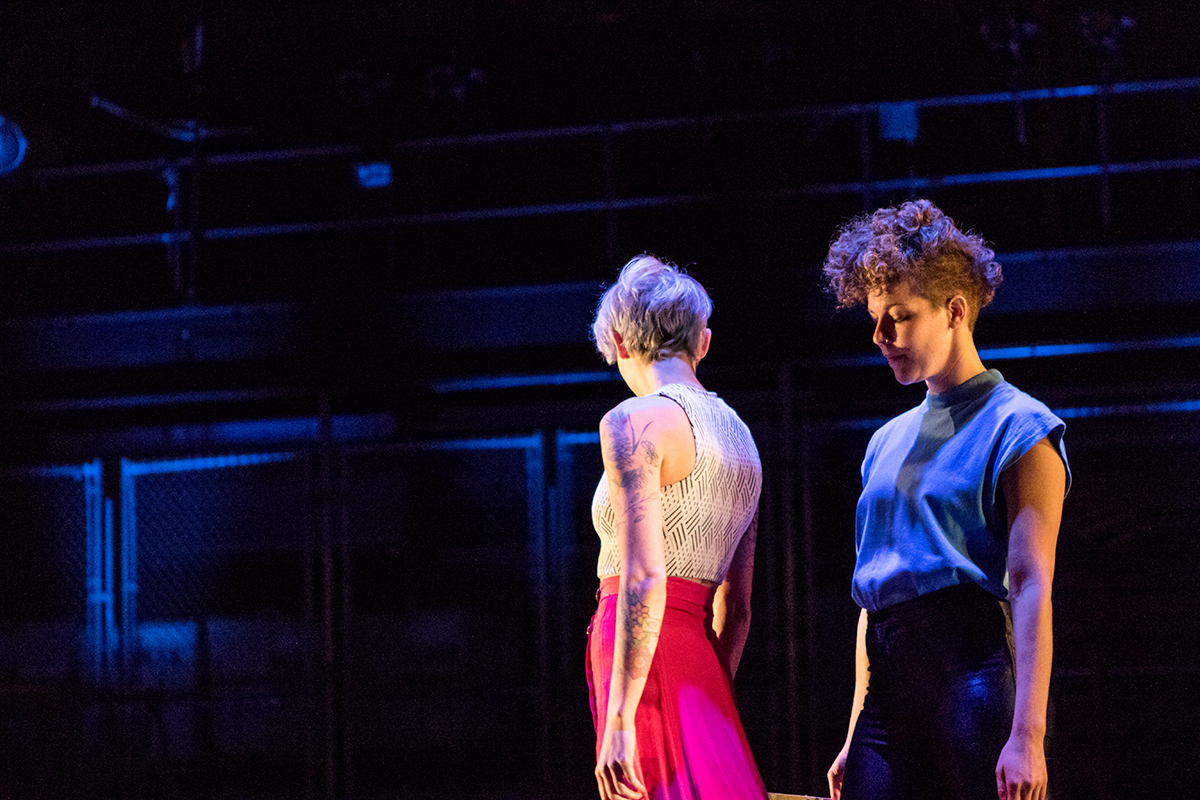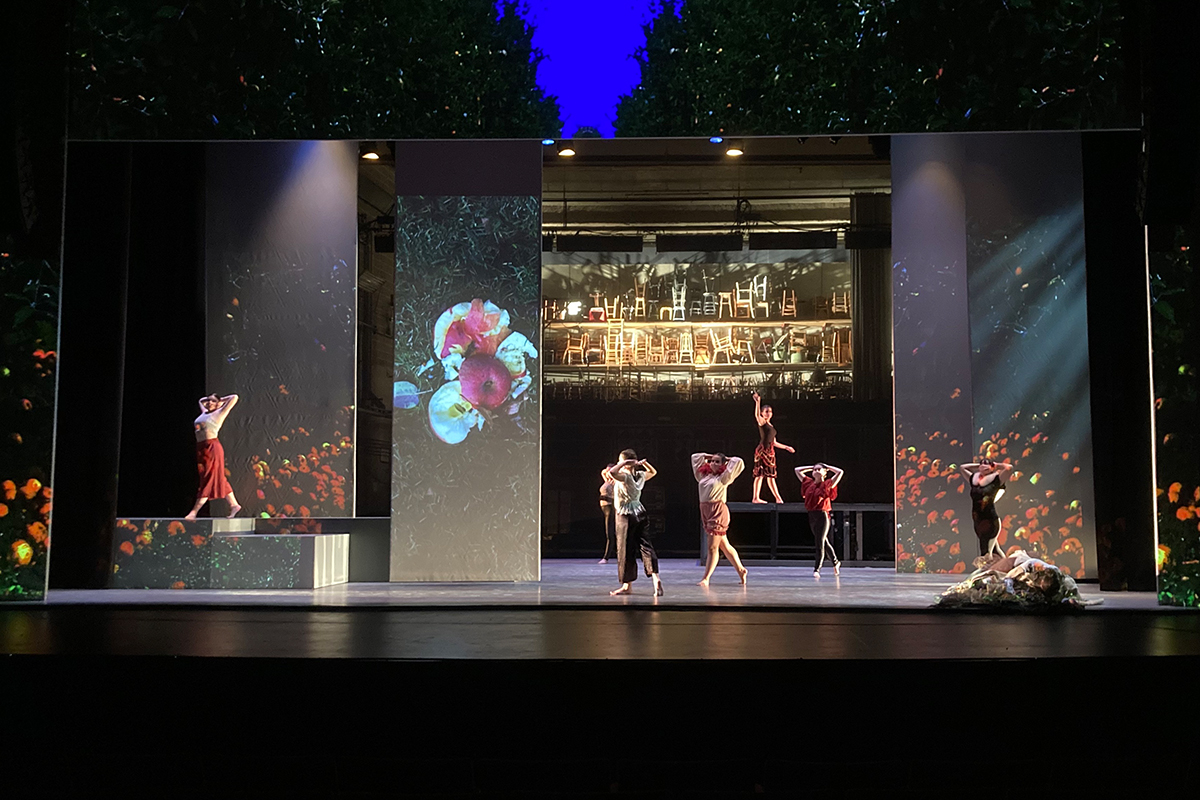
November Dance will feature one piece presented each evening Nov. 5-8 at Krannert Center for the Performing Arts. The dance concert will have a limited live audience, but will be livestreamed.
Photo by Natalie Fiol
CHAMPAIGN, Ill. — Performers at the November Dance concert will dance for the first time on a new set, but most of their audience will watch on screens rather than in person.
The dance department at the University of Illinois at Urbana-Champaign features work by faculty members and students at the annual concert at Krannert Center for the Performing Arts. This year, a maximum of 50 people – U. of I. students, faculty members or staff – will be able to attend the performances, which also will be livestreamed. One piece will be presented each evening from Nov. 5-8, followed by a discussion with the choreographers, performers and designers. A link for the livestream can be found online.
The dancers will perform on a new set designed for the Tryon Festival Theatre at Krannert Center – a new experience for dance department choreographers who do not usually work with a set. Dance professors Sara Hook and Endalyn Taylor will use the tiers of the set to create more dimension on stage, where dancers in the back can be seen as prominently as those toward the front of the stage.

Theatre professor José Díaz-Soto and graduate student Jia "Leo" Zengpeng designed a new set for the November Dance performances. The set includes movable panels that can be used as a canvas for projected images or video, and a series of platforms with steps and ramps to position performers at different heights.
Graduate students Kayt MacMaster and Sarah Marks Mininsohn used those features of the new set for their piece for November Dance, "herd tale."
Photo by Kayt MacMaster
The November Dance works by Hook and Taylor were influenced by the pandemic and the struggle for racial justice.
Because of the difficulties in gathering dancers together to rehearse, Hook asked each of her 10 cast members to learn a different solo from her extensive repertoire of work. The solos will be performed together in an ensemble piece titled "Cedar Closet." The context of the pandemic will be seen clearly, with the dancers wearing masks during the performance.
"We're not pretending we're not in pandemic. One of the dancers will actually be cleaning up after herself and others on stage. She will bring cleaning spray and a pink rag onto the stage and clean a few areas of the stage and set where dancers have been moving," Hook said.
In another moment influenced by the pandemic, two dancers will perform while holding onto an end of a 6-foot stick used in rehearsal for social distancing.
"One of the dancers is a nationally known expert in color guard. She gets a moment to twirl it before she goes offstage," Hook said.
The dances are quite physical and difficult. They were created for the purpose of teaching or experimenting with technical aspects of dance.
"Seeing all these bodies on stage going through their own little gauntlets feels very tied to what our experience is right now," Hook said.
As with the choreography, building costumes from scratch during the pandemic seemed unwise, so Hook used costumes from the dance department's costume shop and her own collection. The title "Cedar Closet" refers to that, as well as to the recent sale of Hook's grandmother's house.
"I have vivid memories of playing dress-up in her large cedar closet. I'm paying homage to that in the title," she said.
The score for the piece includes an audio recording of a real-time music lesson between jazz artist and Illinois music professor Chip McNeil and a graduate student, Saori Kataoka, who is studying trumpet and dance.
Taylor's work for November Dance, "Boxed," questions perceptions of race, gender, age and patriotism.
"It's about the perceptions that people place upon you and label you with, boxing you in in a way that doesn't allow you to be all the things you are or potentially can be. It's about pushing against those perceptions of other people and finding your own identity," Taylor said.
"Boxed" will be performed by 15 dancers, including one whose performance will be via videotape and animation.
"The cast is very diverse, which I love. It's representative of this particular time and what COVID-19 and racial injustice have done: They've isolated us but also united us in fighting for what we believe in," Taylor said.
None of the dancers touch each other during the performance, which was challenging for Taylor, with her ballet background, to choreograph. The piece is based in ballet and influenced by other dance forms, including modern and jazz. She asked the dancers to create movement around a label that has been a struggle for them.
The music will include Taylor's favorite song, Louis Armstrong's "What a Wonderful World," which she has never used with choreography.
"It's so relevant to remind ourselves what our responsibility is to maintain the wonder and beauty of the world we live in," she said. "People who came before us had their COVID-19 moment and lived through racism. They were resilient. There's something to learn from that. They managed to continue to create art in the face of all the struggles."
Graduate students Kayt MacMaster and Sarah Marks Mininsohn choreographed a piece that evokes mythic folklore, with imagery that includes cowgirls, herding, minotaurs, teacups and nests. Graduate student and choreographer Bevara Anderson's work is a meditation on quietude.
José Díaz-Soto, a professor of scenic design in the U. of I.'s theatre department, and Jia "Leo" Zengpeng, a graduate student in scenic design, are the co-designers of the new set being used for November Dance.
Designers usually build sets specifically for the scenes in particular productions, but this set will be a permanent addition and available to many directors and choreographers from the theatre and dance departments and the Lyric Theatre program.
"It was a different challenge and a very creative challenge for us," Díaz-Soto said.
The set had to work as a blank canvas, with tools that can be used to change the look for different productions. It has movable panels that can be used as the canvas for projections of images or video to set a scene. A translucent screen allows the use of silhouettes. Actors and dancers can position themselves at different heights using a series of platforms combined with steps and ramps.
Díaz-Soto and Zengpeng worked with many other departments in designing the set. For example, the color of the panels had to work well for lighting and projections. Painters recommended a finish that could be cleaned easily between productions.
"We designed something that can go from very minimalist and abstract and conceptual to something more realistic with the help of media, lighting and projections," Díaz-Soto said. "We had to think about dance and Lyric Theatre. Each has different challenges."






